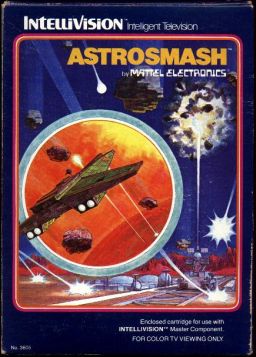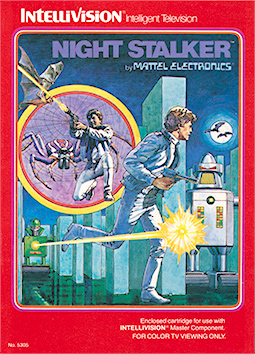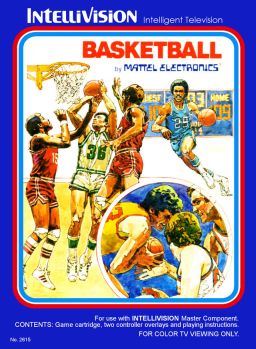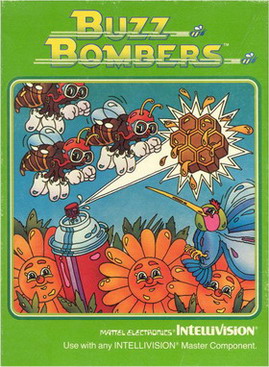
The Intellivision is a home video game console released by Mattel Electronics in 1979. Development began in 1977, the same year as the launch of its main competitor, the Atari 2600. In 1984, Mattel sold its video game assets to a former Mattel Electronics executive and investors, eventually becoming INTV Corporation. Game development ran from 1978 to 1990, when the Intellivision was discontinued. From 1980 to 1983, more than 3.75 million consoles were sold. As per Intellivision Entertainment the final tally through 1990 is somewhere between 4.5 and 5 million consoles sold.

BurgerTime, originally released as Hamburger in Japan, is a 1982 arcade video game from Data East released initially for its DECO Cassette System. The player is chef Peter Pepper, who must walk over hamburger ingredients in a maze of platforms and ladders while avoiding anthropomorphic hot dogs, fried eggs, and pickles which are in pursuit.

Bump 'n' Jump is an overhead-view vehicular combat game developed by Data East and originally released in Japan as Burnin' Rubber. Distributed in North America by Bally Midway, the arcade version was available as both a dedicated board and as part of Data East's DECO Cassette System. The goal is to drive to the end of a course while knocking enemy vehicles into the sides of the track and jumping over large obstacles such as bodies of water.

Astrosmash is a fixed shooter video game for the Intellivision console, designed by John Sohl, and released by Mattel Electronics in 1981. The player uses a laser cannon to destroy falling meteors, bombs, and other targets.

Advanced Dungeons & Dragons: Treasure of Tarmin is a video game for the Intellivision video game console and the Mattel Aquarius computer system. This game was a licensed Dungeons & Dragons adaptation. It is a successor game to Advanced Dungeons & Dragons: Cloudy Mountain (1982).
The Entertainment Computer System (ECS) was an add-on peripheral for the Intellivision. It was Mattel Electronics' second attempt at creating a peripheral to upgrade the Intellivision into a home computer, and was rushed into production to appease the Federal Trade Commission after they began fining Mattel for false advertising following consumer complaints about the repeated delays in releasing the originally planned Intellivision Keyboard Component add-on. The ECS includes the Computer Module, Music Synthesizer, and additional hand controllers; each sold separately. Any Intellivision Master Component is compatible and a requirement to use the system. A second requirement is a cartridge plugged into the ECS, although any ECS or Intellivision cartridge will do; pressing anything on the Intellivision hand controllers will then bring up the three-option menu of BASIC, CARTRIDGE or MUSIC.

Night Stalker is a top-down maze shooter designed by Steve Montero and released for the Intellivision console in 1982. Night Stalker was ported to the Atari 2600 as Dark Cavern and released under Mattel's M Network label. Apple II, IBM PC, and Mattel Aquarius versions were published in 1983.
TV Powww was a franchised television game show format, in which home viewers controlled a video game via telephone in hopes of winning prizes.

Armor Battle is a video game written by Chris Kingsley for the Intellivision and published by Mattel in 1979. One of the earliest games available for the console, Armor Battle pits two players against each other in a contest to see which player can eliminate their opponent's stock of tanks first.

Basketball is a multiplayer sports video game produced by Mattel and released for its Intellivision video game system in 1980. The players each control a basketball team competing in four timed quarters of game play. Mattel obtained a license from National Basketball Association and used the NBA logo in its box art, making it first basketball video game to be licensed by the NBA. NBA Basketball does not use any official team or player names. It was sold by Sears for its private-label version of the Intellivision console, the "Super Video Arcade", without the NBA name or logo.

Triple Action is an action video game produced by Mattel Electronics for its Intellivision video game system in 1981. The game actually includes three separate games—racing, tank combat and flying—where two players compete against each other for the best score.

Buzz Bombers is a fixed shooter video game developed by Mattel Electronics for its Intellivision system and released in 1982. Mattel's reaction to Atari's popular Centipede, the player controls a can of bug spray trying to ward off swarms of bees.

Star Strike is a single-player video game, released by Mattel for its Intellivision video game system in 1981. The Intellivision's best-selling game in 1982, with over 800,000 copies sold, Star Strike was inspired by the attack on the Death Star in the 1977 film Star Wars. The player must drop bombs on alien weapons silos before Earth moves into range.

Hover Force is a video game published by INTV Corporation for the Intellivision video game system in 1986. The game was initially developed by Mattel Electronics with the intent of it being played in 3-D, but the company was shut down before it could be released. INTV, after acquiring the Intellivision assets from Mattel, re-tooled the game, which pits players against a terrorist group laying siege to a city, and then released it.

Space Hawk is a multidirectional shooter released by Mattel for its Intellivision console in 1982. The game is a re-worked version of a previously planned clone of Asteroids in which the player, in a rocket-powered space suit, is drifting in space and shooting down or avoiding targets, including the titular hawks.

Skiing is a sports video game produced by Mattel and released for its Intellivision video game system in 1980. Up to six players compete individually on either a downhill or slalom course to see who can complete the course the fastest. For the game's initial release, Mattel obtained a license from the U. S. Ski Team and used its name and logo in the game's box art. In 1988, INTV Corporation released an enhanced version of the game entitled Mountain Madness: Super Pro Skiing.

Snafu is a video game released by Mattel for its Intellivision video game system in 1981. One of a number of snake games released in the late 1970s and early 1980s, Snafu features players controlling ever-lengthening serpents as they attempt to corner their opponents and trap them.

NFL Football is a sports video game developed by Mattel and released for its Intellivision video game system in 1979. The players each control a football team competing in a standard four-quarter game. Like Mattel's other sports video games, NFL Football did not use any official National Football League team names or player names, even though Mattel obtained a license from the NFL and used the league's logo in its box art. NFL Football has been cited as the first football video game to have a playbook.

Thunder Castle is a 1986 maze video game for the Intellivision. The player controls a knight navigating three mazes, defeating enemies to progress. To defeat the enemies, the knight must be energized before interacting with them.
















